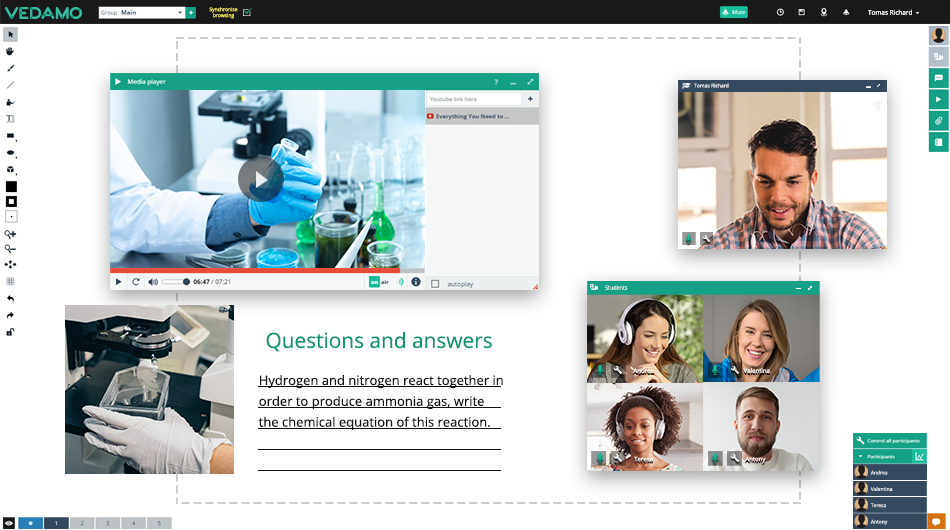In a sequence of several articles we will cover all the aspects of an online assessment. Today we will talk about the specifics of a live online assessment and the kinds of tools online teachers can use to better evaluate their students.
What you should know about live assessment in a virtual environment?
The main objective of all assessment techniques is to understand if and how well your virtual student has understood the teaching material. The virtual classroom offers alternative assessment practices to the traditional face-to-face method; however, teachers need to be more creative when using different online assessment tools.
The other important advantage to online assessment is that it can be done during every step of the teaching process. In many online courses the online learner cannot advance unless they pass a certain level of competence.

Before the creation of the assessment method, the online teacher should be aware that:
- Assessment activities should be aligned to the learning objectives, particularly if the activities are formally assessed and graded.
- The assessment rubric should be clearly worded. The teacher should have a clear idea of what their students should achieve, as well as the features and skills to be measured.
- The teacher should consider balancing formative and summative assessments.
Formative assessments aim to monitor student learning and to provide ongoing feedback that can be used by instructors to improve their teaching methodology and by students to improve their learning. Formative assessments are generally low stakes, which means that they have low or no point value.
Summative assessments aim to evaluate student learning at the end of an instructional unit by comparing it against some standard or benchmark. Summative assessments are often high stakes, which means that they have a high point value.
The physical distance between teacher and student, the use of technology in order to communicate with students, and the workload and time management can be considered as challenges to the online assessment process.
Nevertheless, there are different techniques available to the teacher that can be used to correctly assess the progress of their students.
During the live course the teacher can evaluate the students by using the following tools:
Chat Tool – This tool offers a plethora of options. For example, while students are watching a video or a presentation, they can answer different questions or write down their opinions.
Personal Notes Tool – Teachers can give students critical thinking questions based on a lesson or a reading and then ask them to reflect on both. The answers are posted to the Whiteboard and their peers are given the chance to respond. On VEDAMO’s Online Whiteboard virtual learners can write down their answers, share ideas about the learning material, and discuss them with the peers.
LMS Quiz Tool – This allows teacher to create different types of quizzes and polls. The quiz is a great opportunity for students to answer questions truthfully and to see in real time how they stack up to the rest of the class. Quizzes are really powerful because teachers can immediately see the results. They can also be paired with questions on the Whiteboard. Students may be polled first and then asked to explain why they answered the way they did on the Whiteboard.
Live Quiz Games – Learning through play is a method of knowledge acquisition that can be more
effective and amusing for learners. Teacher can create different games by using VEDAMO’s
Whiteboard, its tools, and a media player.
Live Assessment Based on Videos – Teacher can show an interesting video during the online class and then provoke a discussion on the online whiteboard or create a short quiz or poll related to its content.

Digital Exit Cards – If a teacher wants to verify a student’s understanding of the lesson in a short amount of time, then one-minute papers or exit cards are a very good option. They force the learners to exercise their critical thinking ability in short responses. These questions can be asked via VEDAMO’s chat where learners have the option of sending general chat or personal chat messages to their peers or to their instructor.
Online Interviews – Although this is a practice that is convenient for a smaller group and, in fact, requires face-to-face online interaction, online interviews are a good choice if a teacher wants to focus on and to individually support some of their students. Instructors should prepare a list of questions and a process for the interview. This type of communication allows teachers to address the challenges and concerns of the students and to give them methods to overcome them. In addition, interviews provide teachers with feedback about their online course that they can use to make changes if they are needed. These types of interviews can be organized through VEDAMO’s
Videoconferencing.
In the end, let’s not forget:
“The test of a good teacher is not how many questions he can ask his pupils that they will answer readily, but how many questions he inspires them to ask him which he finds it hard to answer.” – Alice Wellington Rollins
